How to Make Your RV Air Conditioner Colder and More Efficient
If you’ve ever spent a summer in your RV, you know how essential it is to keep the interior cool and comfortable. Whether you’re planning to hit the road or already living the RV lifestyle, knowing how to make your RV air conditioner colder and more efficient can save you money and energy. Below are key steps you can follow to maximize your RV’s cooling power.
1. Park in the Shade and Create Shade
One of the simplest and most effective ways to keep your RV cool is by strategically parking it in the shade.
Why Parking in the Shade Helps:
When your RV is exposed to direct sunlight, the temperature inside can rise quickly, overwhelming the air conditioner. By parking your RV under trees, awnings, or large structures, you can significantly reduce the heat entering the RV, allowing your AC unit to work more efficiently. Shade prevents the sun from heating the roof and windows, which are typically the primary heat sources.
How to Create Shade for Your RV:
If natural shade is unavailable, consider setting up additional shade structures like pop-up canopies, tarps, or RV awnings. Another option is using reflective tarps to cover windows and doors, creating an extra barrier between the sun and your RV.
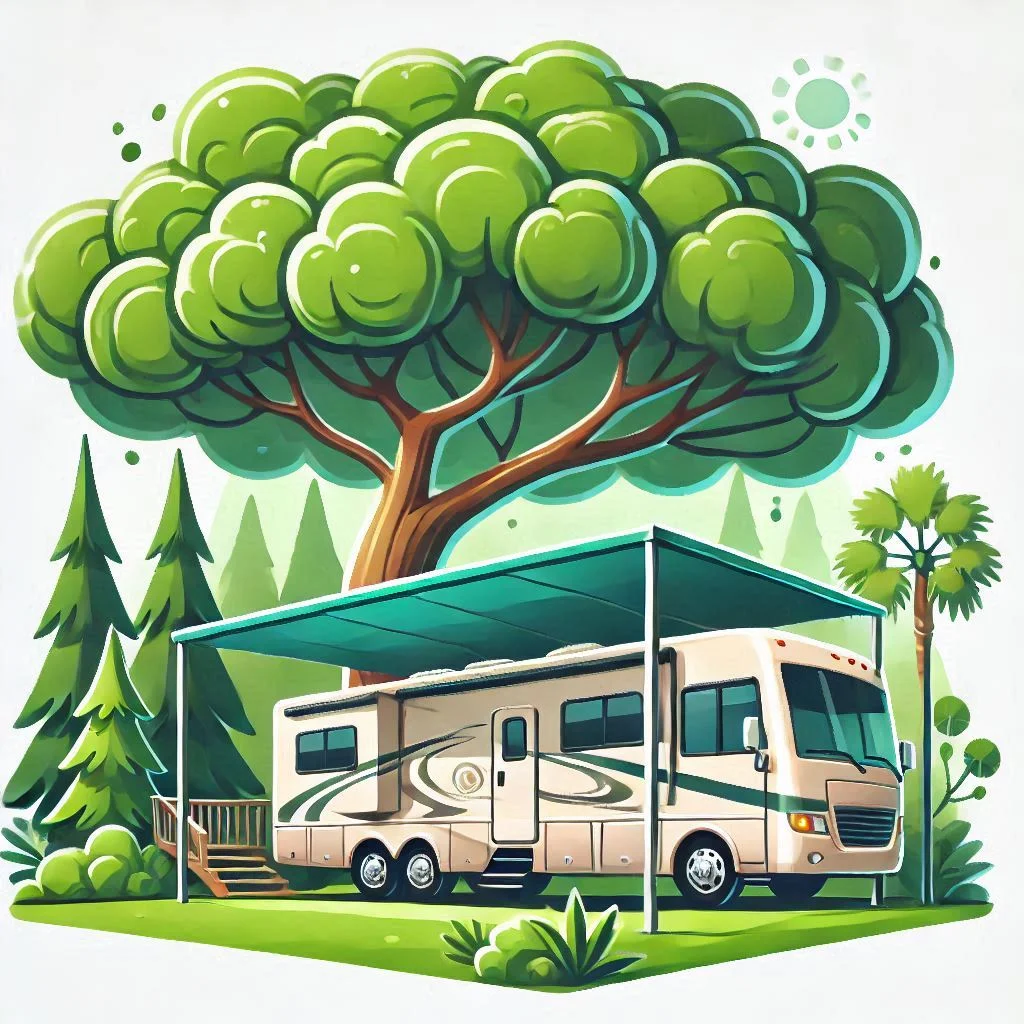
2. Protect and Cover Your RV Windows
Windows are a major source of heat entering your RV. By using proper window covers, you can block out sunlight and reduce the temperature inside.
Installing Reflective Window Covers:
Reflective window covers are designed to bounce back the sun’s rays, preventing them from heating the interior. These covers are especially effective on windows that face the sun during the day. You can find reflective covers made of high-quality, heat-resistant materials that you can easily install and remove.
The Importance of Closing Windows Early:
Keeping windows open during the hottest parts of the day lets in hot air. To trap the cooler morning air inside your RV, close the windows early in the day, especially if you are using reflective window covers. When the sun sets, you can open the windows again to allow fresh, cooler air to flow in.
Additional Tips:
- Consider using heat-insulating window film that not only blocks sunlight but also provides privacy.
- Use thick curtains or blackout shades for added insulation.
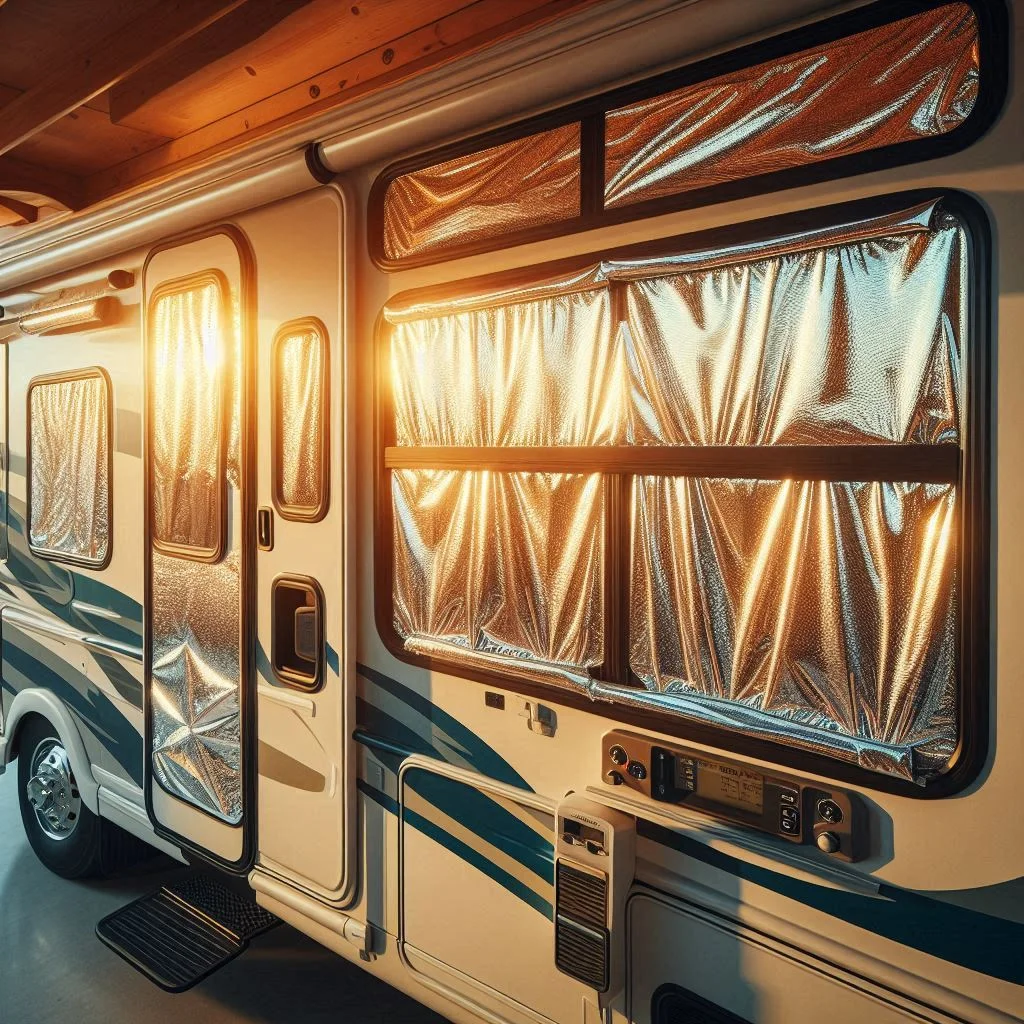
3. Keep Your Cooling System Efficient
Maintaining your RV’s cooling system is crucial to ensuring it runs efficiently and keeps the interior comfortable. Regular upkeep of your AC unit can prolong its lifespan and improve its cooling performance.
Regular Maintenance and Cleaning of AC Units:
AC units, like any other appliance, require routine maintenance. Clean the filters and coils regularly to prevent dirt and dust from blocking airflow. Clogged filters reduce cooling efficiency and force the system to work harder, leading to higher energy consumption.
Using Swamp Coolers to Enhance Cooling:
Swamp coolers, or evaporative coolers, are a great alternative to traditional air conditioning in dry climates. These systems use water evaporation to cool the air, which can be particularly helpful in areas with low humidity. If your RV is in a dry environment, a swamp cooler can be used in tandem with your AC unit to lower the temperature inside the RV.
Other Cooling System Tips:
- Check for any leaks or damage to the AC unit that might affect its cooling efficiency.
- Ensure that your RV’s insulation is intact to prevent cool air from escaping.
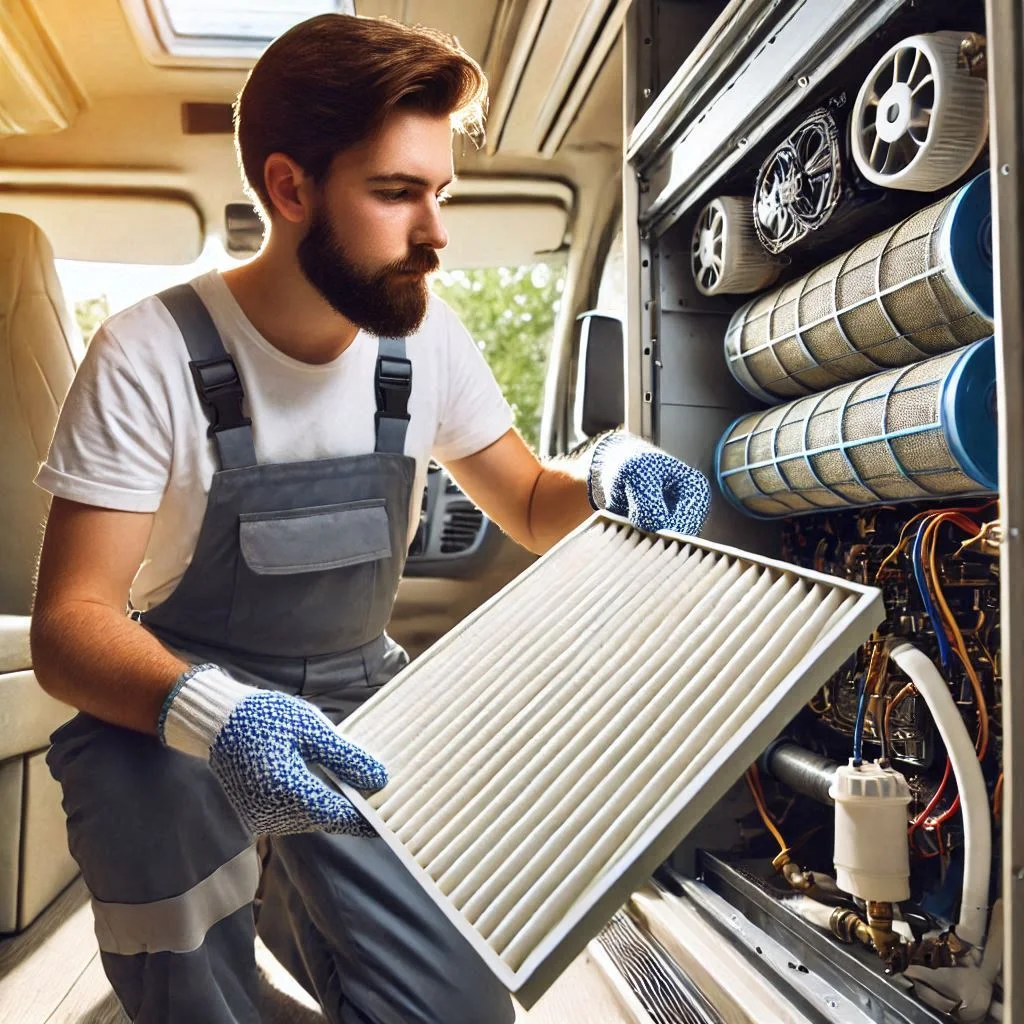
Tricks to Enhance Airflow and Ventilation for Better Cooling
Proper airflow and ventilation are key to ensuring your RV stays cool and comfortable during those hot summer days. Whether you’re parked in a remote location or at a busy campground, there are several strategies to help improve air circulation inside your RV. Below, you’ll find simple tricks to enhance ventilation and create a cooler environment, making your air conditioner work more efficiently.
4. Increase Ventilation and Go with the Flow
Air circulation is crucial to maintaining a comfortable temperature in your RV. By strategically increasing ventilation, you can help your air conditioning system do its job more effectively.
Open Vents to Allow Air Circulation:
RV ventilation systems are designed to move air in and out of your vehicle, but this system only works if the vents are open. Open ceiling vents, roof vents, and side windows (if safe to do so) to allow hot air to escape and fresh air to enter. Make sure that the ventilation system is unobstructed by debris, and adjust the vents as needed to direct airflow through the RV.
Creating Cross-Ventilation:
To maximize airflow, create a cross-breeze by opening windows on opposite sides of the RV. This creates a path for air to flow through, naturally cooling the interior. If you’re in an area with light winds, this simple trick can make a significant difference.
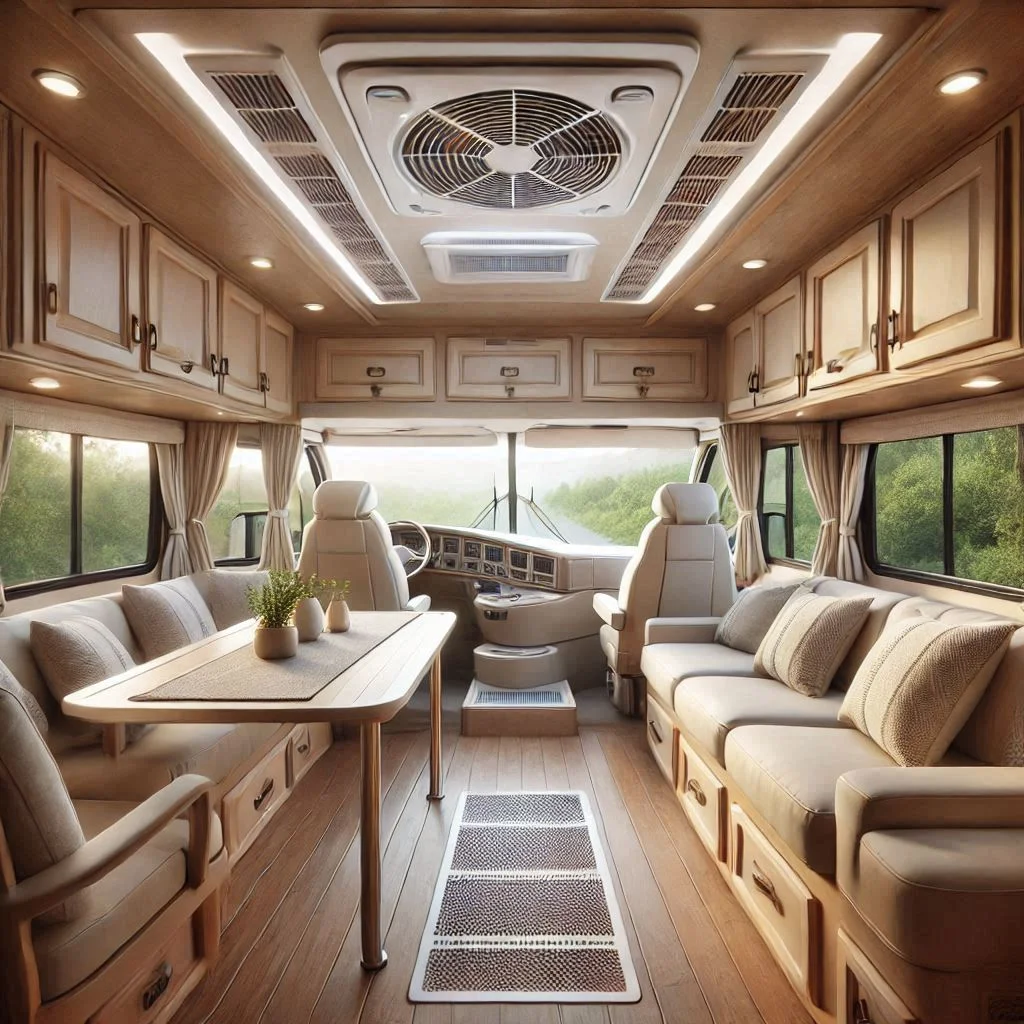
5. Buy a Portable Fan (or Two)
While your RV air conditioner may do most of the heavy lifting when it comes to cooling, portable fans are a simple, cost-effective way to enhance the airflow and help cool your RV more quickly.
Utilize Fans to Circulate Cool Air Effectively:
Portable fans can distribute the cool air generated by your AC unit more evenly throughout the space. Place fans strategically around the RV, particularly in areas where airflow is less effective, such as near the back or corners. Consider investing in oscillating fans or tower fans, which are designed to cover a wider area and move air in various directions.
Why Two Fans Are Better Than One:
Using two fans can help create an even stronger airflow, especially if you place them across from each other to boost cross-ventilation. Position one fan near the front of the RV to pull in cooler air, and the other near the back to push the warm air out.
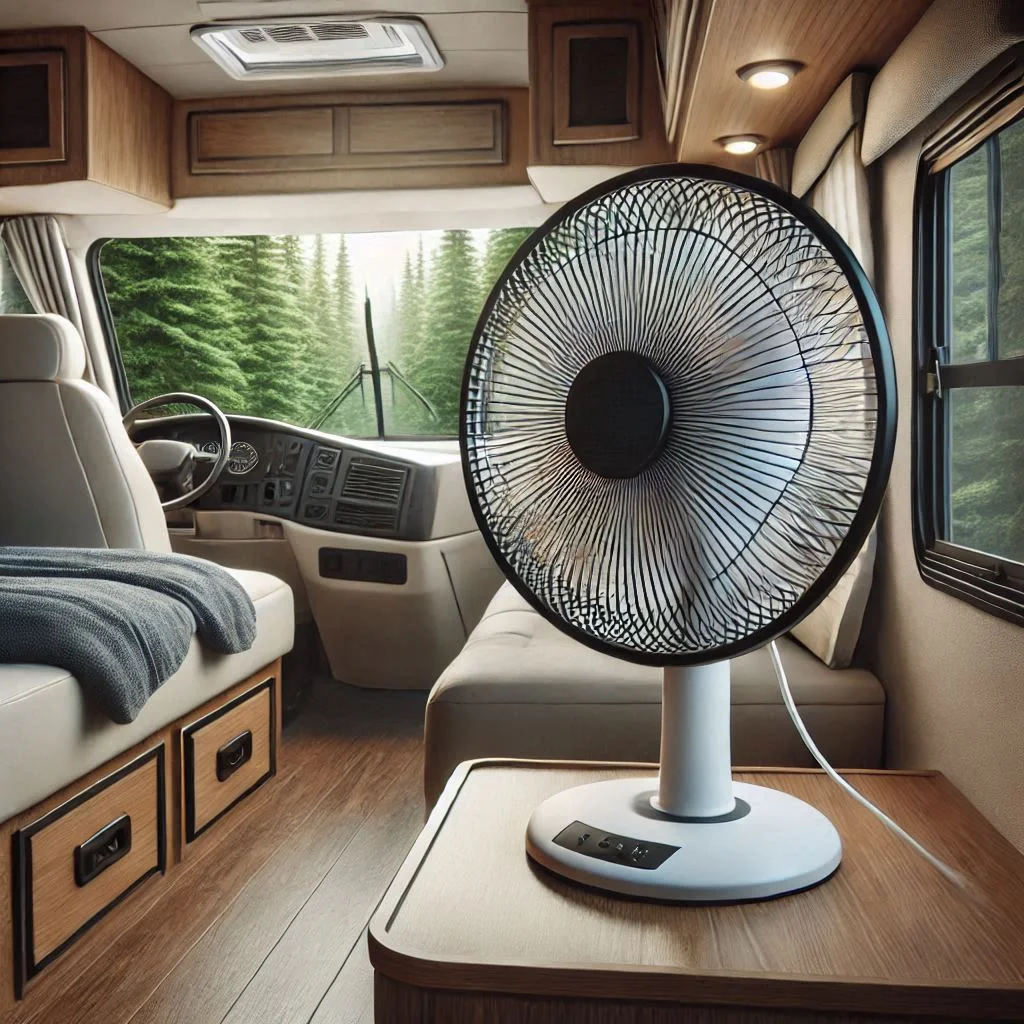
6. Cook Al Fresco to Avoid Heat Build-up
Cooking inside your RV on a hot day can quickly add to the overall heat, making it more difficult to keep the interior cool. Instead of using your RV’s stove or oven, consider preparing your meals outside to minimize heat buildup.
Prepare Meals Outside to Reduce Internal Heat:
Set up a portable cooking station outside your RV, where you can cook meals on a grill, camp stove, or even a portable induction cooktop. Cooking outdoors prevents the heat from your stove or oven from warming up the inside of your RV, allowing your air conditioning system to work less hard.
Additional Benefits of Cooking Al Fresco:
- It reduces the smell of cooking lingering inside your RV.
- It frees up space in the RV, allowing for more airflow and cooling options.
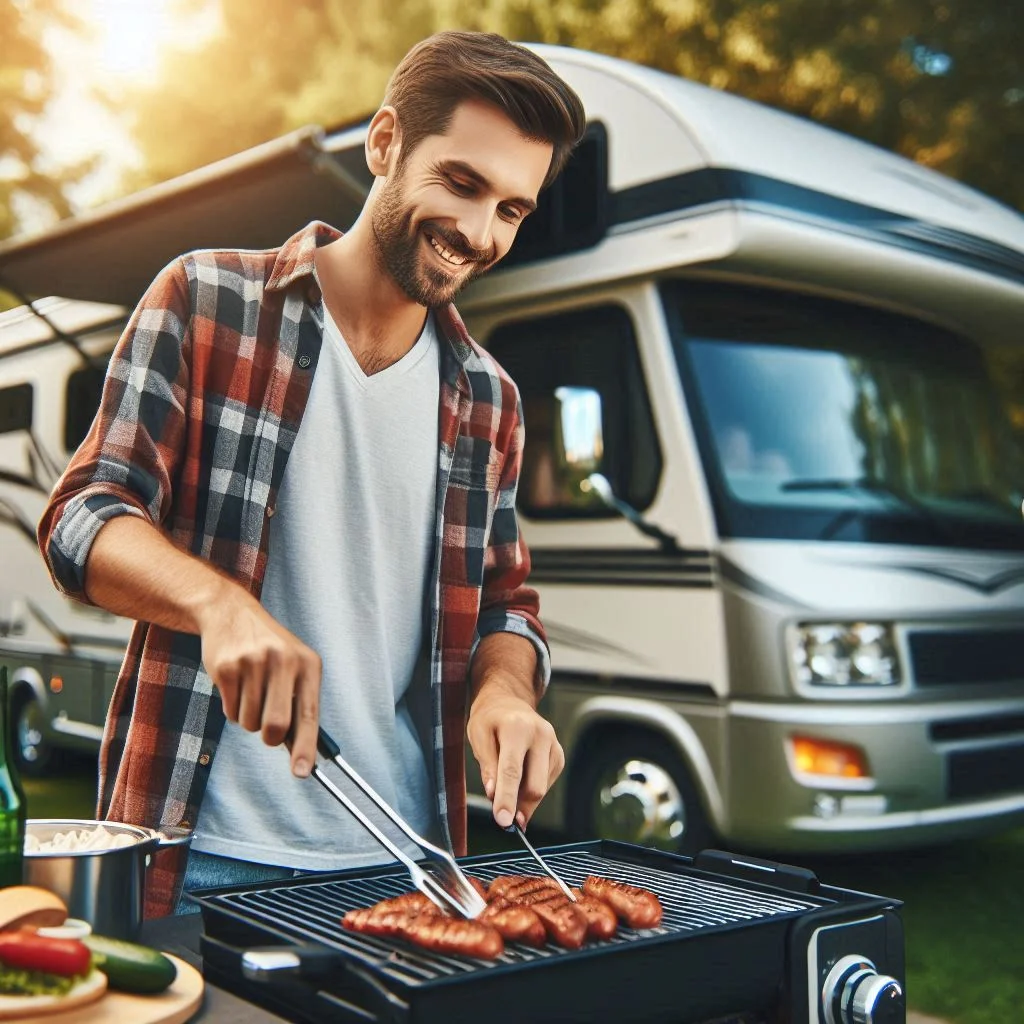
Maximizing Efficiency with Insulation and Reflective Materials
Maximizing the efficiency of your RV’s cooling system goes beyond simply using a powerful air conditioner. One of the most effective ways to keep your RV cool and reduce the workload on your AC unit is by investing in high-quality insulation and reflective materials. These materials not only block heat from entering your RV but also keep the cool air inside. Here’s how you can enhance your RV’s cooling system with insulation and reflective materials.
7. Use Reflective Insulation for Extra Protection
Reflective insulation is one of the most efficient ways to keep your RV cool. This material works by reflecting radiant heat away from your RV, keeping the interior temperature down without the need for heavy, space-consuming insulation.
Insulate Walls, Windows, and Doors with Reflective Materials:
Reflective insulation is typically made from a foil or aluminum material that can be easily installed in your RV. It’s commonly used on walls, windows, and doors, as these are the areas most prone to heat transfer. Installing reflective insulation on your windows, for example, can block a significant amount of heat from entering your RV during the hottest parts of the day.
- On Walls: Apply reflective insulation to the interior walls of your RV, particularly those that face the sun, to keep the heat from radiating into your living space.
- On Windows: Use reflective window coverings or films that act as a barrier against the sun’s rays, helping to maintain a cooler environment.
- On Doors: Since RV doors are often made from thinner materials, adding a reflective barrier can drastically reduce heat gain and loss.
Why Reflective Insulation Works:
Reflective insulation reflects heat rather than absorbing it, which is ideal for hot climates. Unlike traditional insulation that works by trapping heat, reflective materials keep your RV cooler by pushing the heat away. This allows your air conditioning system to run more efficiently and keeps the internal temperature comfortable for longer periods.
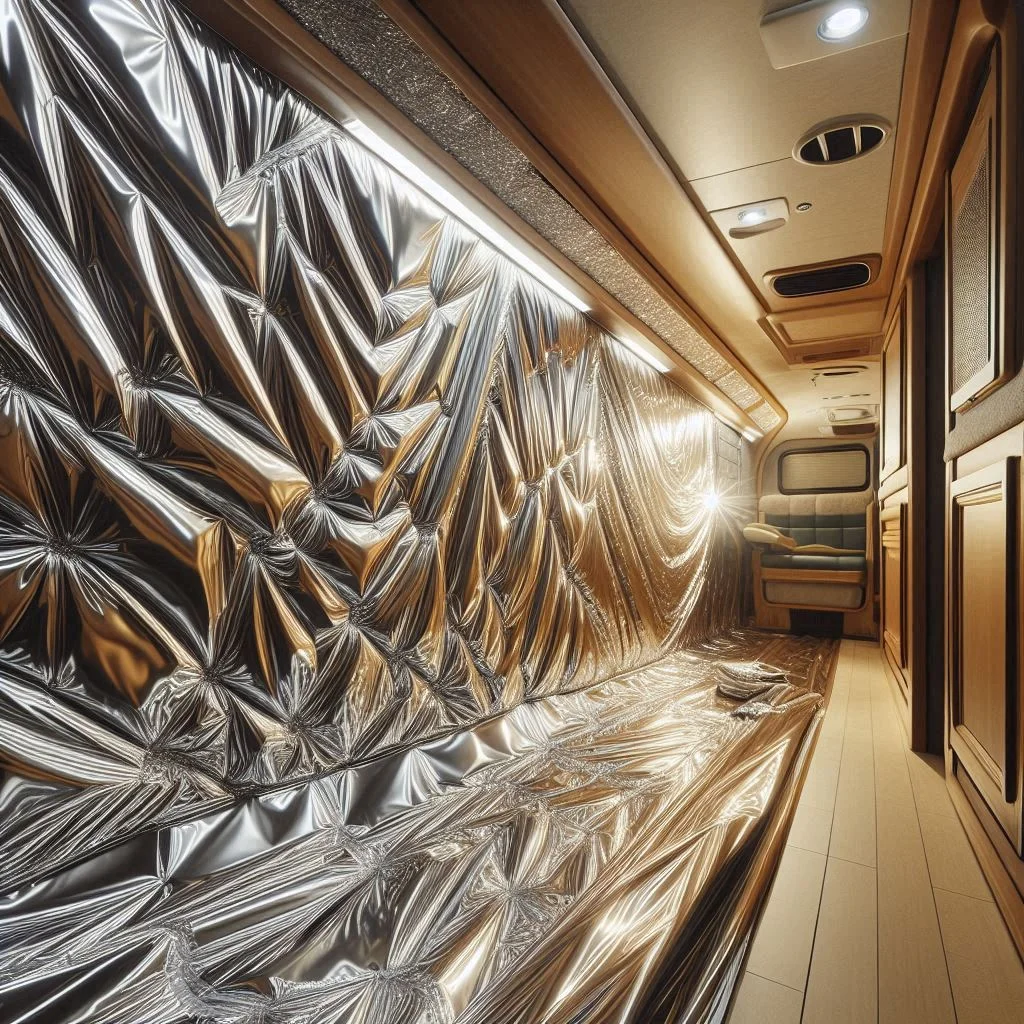
8. Cover Skylights and Keep Your Door Shaded
Skylights and doors are often overlooked when it comes to cooling your RV, but these areas can significantly contribute to heat gain. By covering skylights and keeping your door shaded, you can dramatically improve your RV’s energy efficiency and comfort level.
Prevent Heat from Entering Through Skylights:
Skylights are a great way to let in natural light, but they can also be a major source of heat. During the day, the sun’s rays can pass through the glass and heat the interior of your RV. Covering skylights with reflective or insulating materials can help block out a significant amount of heat. You can use reflective shades, films, or even custom covers to fit over your skylights, providing an extra layer of protection.
- How to Cover Skylights: Install a reflective cover or a light-blocking shade directly on the skylight, or use a flexible, insulating material to block the sunlight. This will reduce heat buildup inside the RV and help maintain a cooler temperature.
Keep Your Door Shaded:
The door to your RV is another entry point for hot air. It’s often exposed to direct sunlight, and with the door opening and closing frequently, it can become a source of heat loss and gain. Using a shade or awning above the door can keep the direct sun from raising the temperature inside your RV. You can also apply reflective window film to the door itself, especially if it’s made of clear material.
Additional Tip:
Consider installing a small, reflective awning or using a portable sunshade to cover the area around your RV’s door. This extra layer of protection will prevent the door from absorbing the sun’s heat, contributing to a more comfortable interior.
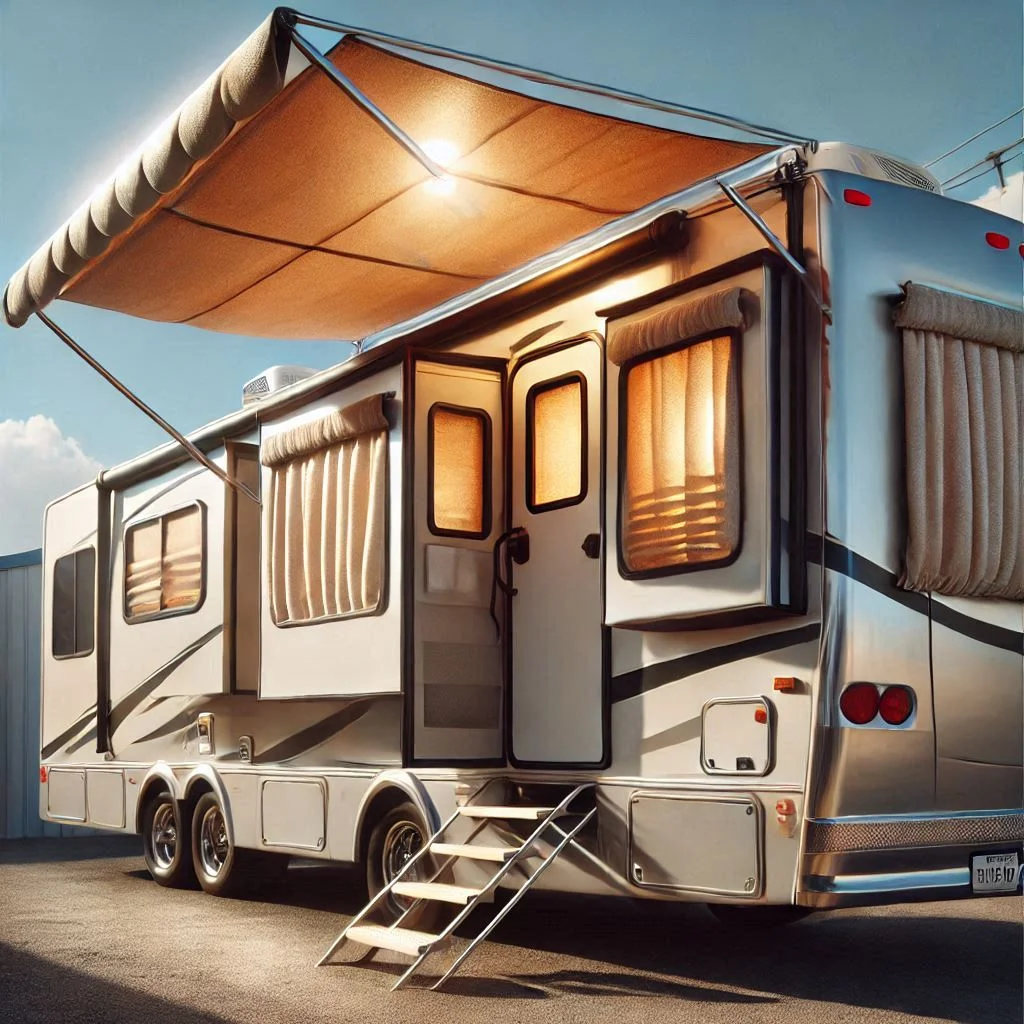
Power Down Electronics and Appliances to Maintain Cool Air
Managing the internal temperature of your RV is not just about cooling the air – it’s also about minimizing the factors that add extra heat to your living space. Electronics and appliances, while convenient, generate a surprising amount of heat that can affect your air conditioner’s performance. Powering down unused electronics and switching to energy-efficient lighting can significantly improve your RV’s cooling efficiency. Let’s explore how you can reduce heat generation by managing your appliances and electronics.
9. Keep Electronics Powered Off When Not in Use
Many people don’t realize that their electronic devices and appliances contribute to the heat buildup in their RVs. Items like televisions, laptops, microwaves, and even small kitchen appliances can generate significant heat, which forces your air conditioning unit to work harder to maintain a comfortable temperature.
Minimize Heat Generated by Appliances and Electronics:
The simplest way to keep your RV cool is by turning off electronics when they are not in use. This includes devices like laptops, smartphones, TVs, radios, and any kitchen gadgets like toasters or coffee makers. These devices don’t just consume power – they also release heat that raises the temperature inside your RV, making it harder for your air conditioner to keep the space cool.
Strategically Powering Down:
- Turn off electronics when not in use, especially during the day when you’re trying to keep the temperature down.
- Unplug devices to prevent standby power consumption, which can still generate a small amount of heat even when turned off.
- Consider using smart power strips that automatically cut off power to devices when they’re not in use. This will reduce the amount of heat emitted by idle electronics and save on electricity.
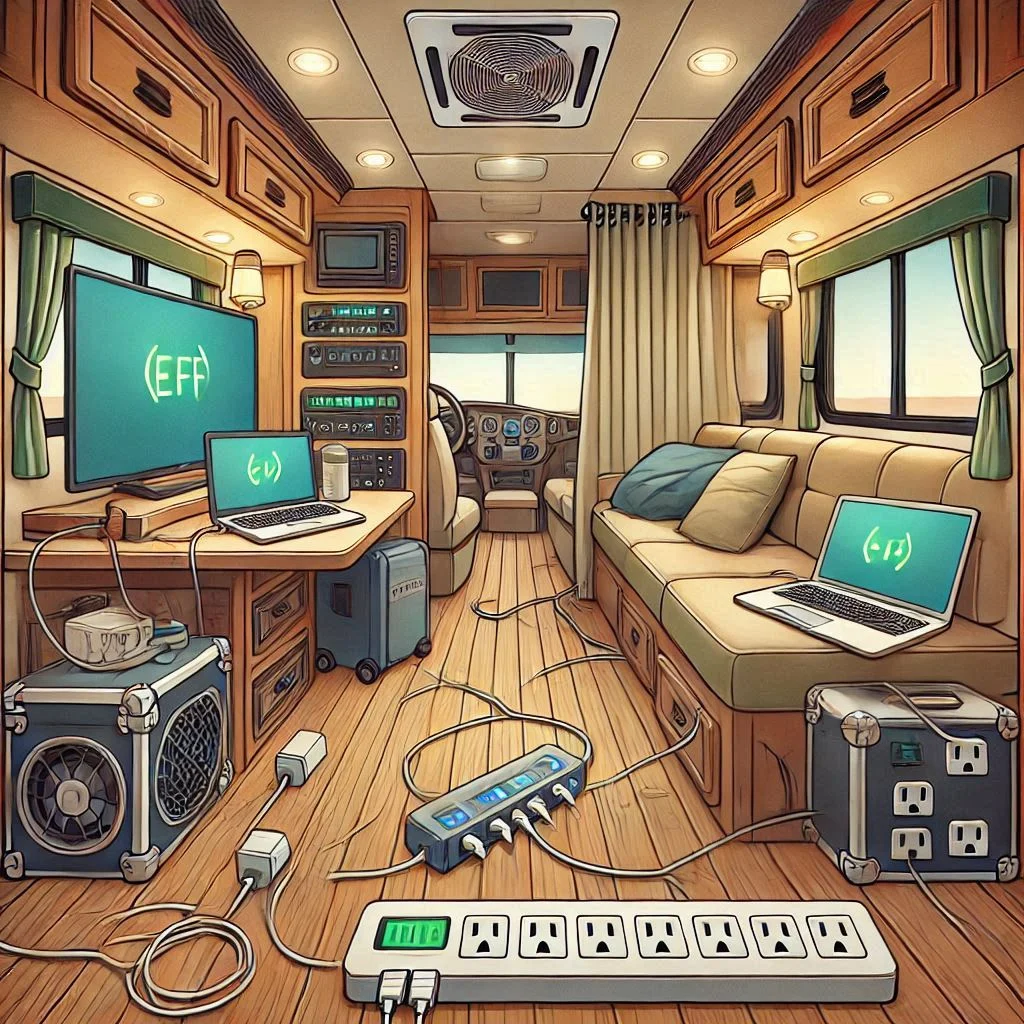
10. Use LED Lights to Reduce Heat Emission
Conventional incandescent bulbs can generate a surprising amount of heat, adding to the overall temperature inside your RV. Swapping them out for LED lights can not only save you energy but also reduce the heat emitted by your lighting fixtures.
Switch to Energy-Efficient Lighting Options:
LED lights are an excellent alternative to traditional bulbs because they emit very little heat compared to incandescent or halogen bulbs. By replacing all your RV’s lighting with LED lights, you can cut down on heat generation, making it easier for your air conditioner to keep the interior cool.
- Why LED Lights are Ideal for RVs:
LEDs consume less power, emit minimal heat, and have a much longer lifespan than traditional bulbs. This makes them a cost-effective option for RV owners who want to save on electricity while maintaining a cool interior. - Where to Replace Lights:
Start by replacing high-usage areas like kitchen lights, bathroom lights, and the main living space. You can also replace exterior lighting, such as porch lights, with LED options to reduce the overall energy consumption of your RV.
Additional Benefits:
In addition to keeping your RV cooler, LED lights can also help extend your RV battery life if you are boondocking or camping off the grid. With the ability to run longer without draining power, LEDs provide a steady light source without the added heat or energy consumption.
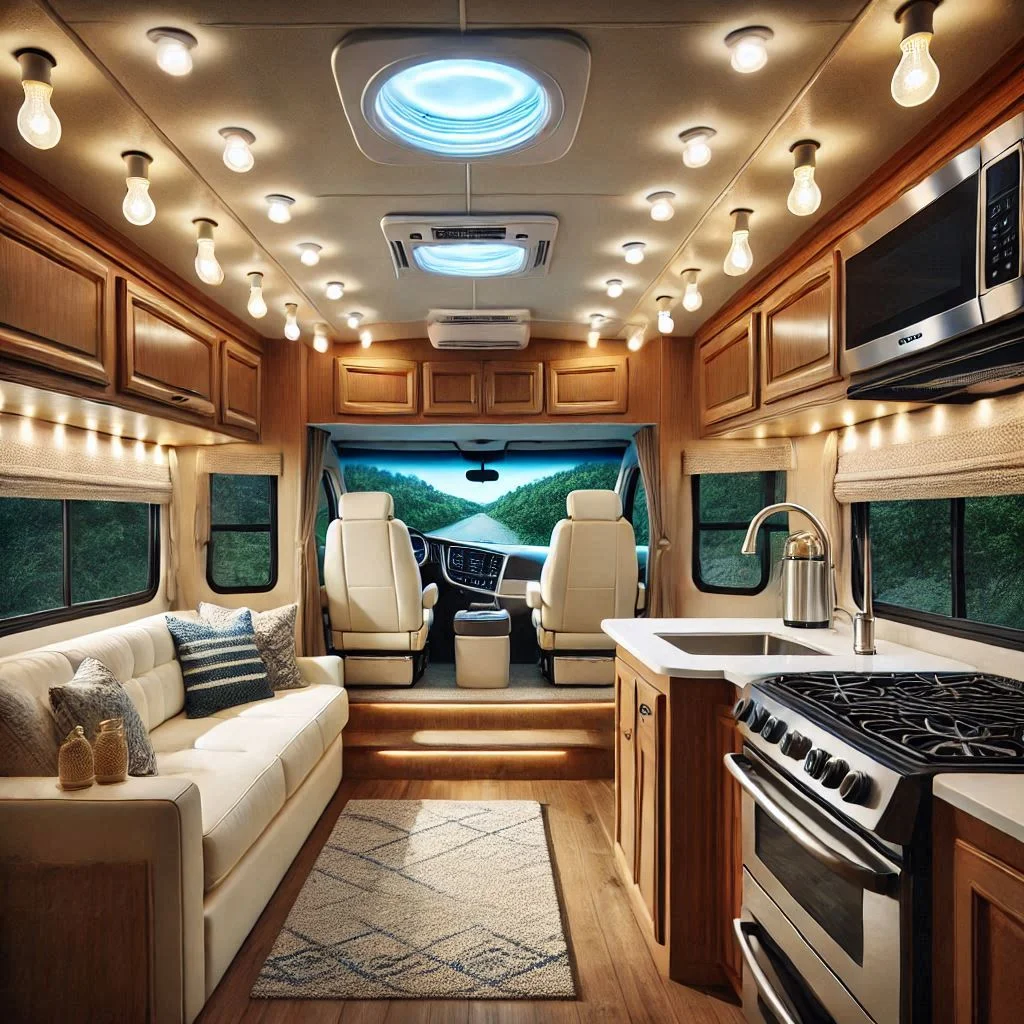
Regular Maintenance for Optimal Cooling Performance
Maintaining the performance of your RV’s cooling system requires more than just turning it on and off. Regular maintenance ensures your air conditioner is running efficiently and that there are no obstructions that could hinder airflow or cooling capacity. Two essential aspects of this maintenance include cleaning fridge and AC vents and keeping the door closed to prevent warm air from entering. By staying on top of these tasks, you can ensure optimal performance and enjoy a cooler, more comfortable living space.
11. Clean Fridge and AC Vents Frequently
Proper airflow is essential for both your refrigerator and air conditioning unit to function efficiently. When vents become clogged with dust, debris, or dirt, it restricts the airflow, which can reduce the cooling efficiency of both systems. Cleaning these vents regularly will ensure that your fridge and AC units continue to operate at their best, keeping your RV cooler.
Ensure Proper Airflow by Cleaning Vents:
- Air Conditioner Vents: Dust and dirt can accumulate in the AC vents and filters, leading to decreased airflow and less efficient cooling. Over time, this can strain your AC unit and lead to higher energy consumption. To avoid this, clean the vents and replace filters every 1-2 months, especially if you’re in a dusty environment.
- Fridge Vents: The refrigerator in your RV needs to be well-ventilated to work properly. Blockages or dust buildup around the vent areas can cause the fridge to run inefficiently, using more power and generating excess heat. Clean the vents by using a soft brush or compressed air to remove any buildup.
Steps for Cleaning:
- Turn off the AC and fridge before cleaning.
- Use a vacuum cleaner or a brush to clean the vents.
- Wipe down the areas around the vents with a damp cloth.
- If the filters are dirty, replace them or clean them according to the manufacturer’s guidelines.
By keeping the vents and filters clear of debris, you can ensure that your cooling systems operate more efficiently, reducing the load on your AC and fridge while maintaining a cooler environment inside your RV.
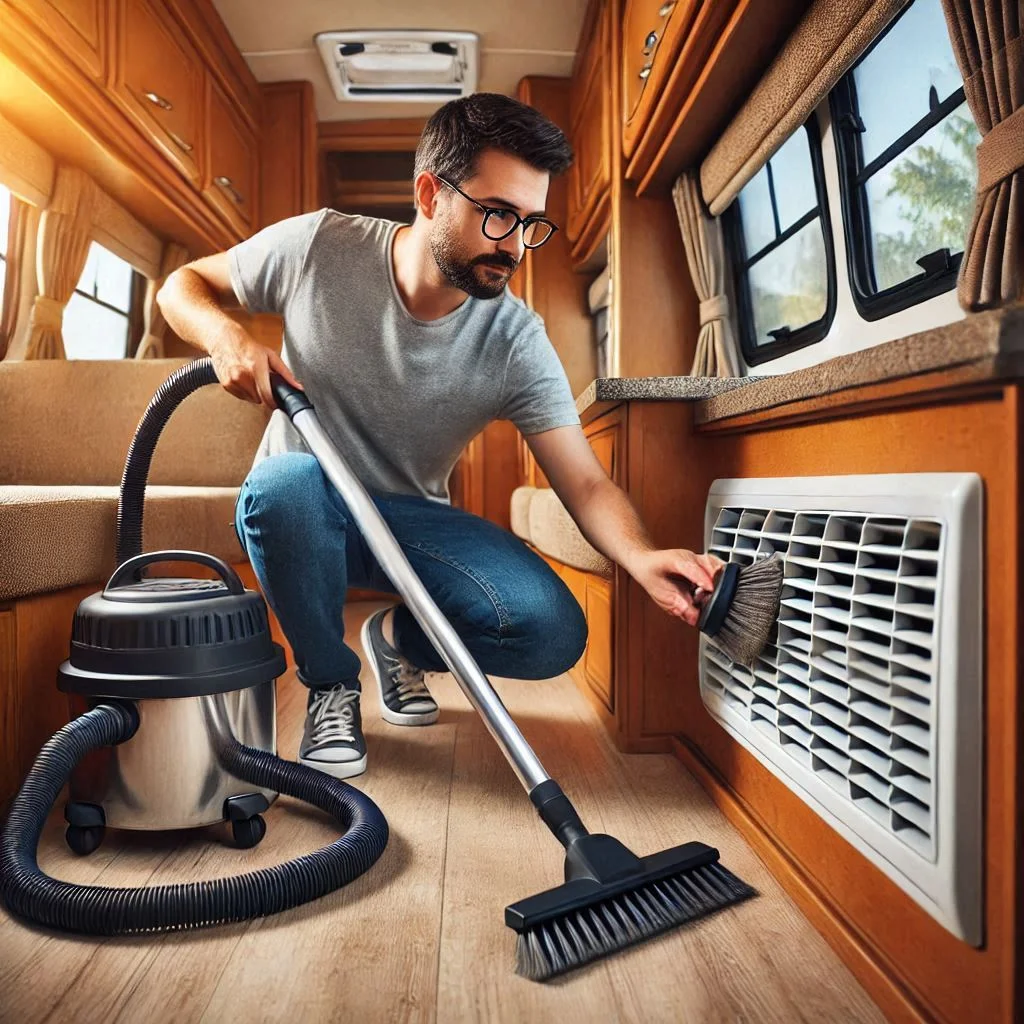
12. Close the Door to Trap Cool Air Inside
One of the simplest yet most effective ways to maintain a cool internal environment in your RV is by keeping the door closed. When the door is open, hot air from outside enters, which increases the workload on your air conditioning unit. By simply closing the door and preventing unnecessary heat influx, you can keep the cooler air inside longer, reducing the need for constant cooling adjustments.
Keep the Door Closed to Maintain a Cooler Internal Environment:
- Avoid Opening the Door Frequently: Every time you open the door, warm air from outside enters, forcing your air conditioner to work harder to cool down the space. Try to minimize door openings, and when you do open it, do so quickly to reduce the amount of hot air that enters.
- Use the RV’s Entryway Effectively: Install heavy-duty weather stripping or door seals to ensure that hot air doesn’t seep in around the door. Additionally, keep the door and windows shut during the heat of the day when your AC is working its hardest.
Additional Tips:
- Install an RV door screen to let fresh air in without opening the door fully. This helps maintain airflow without introducing excessive heat.
- Consider an RV door fan to increase air circulation when the door is closed, helping the AC perform more effectively.
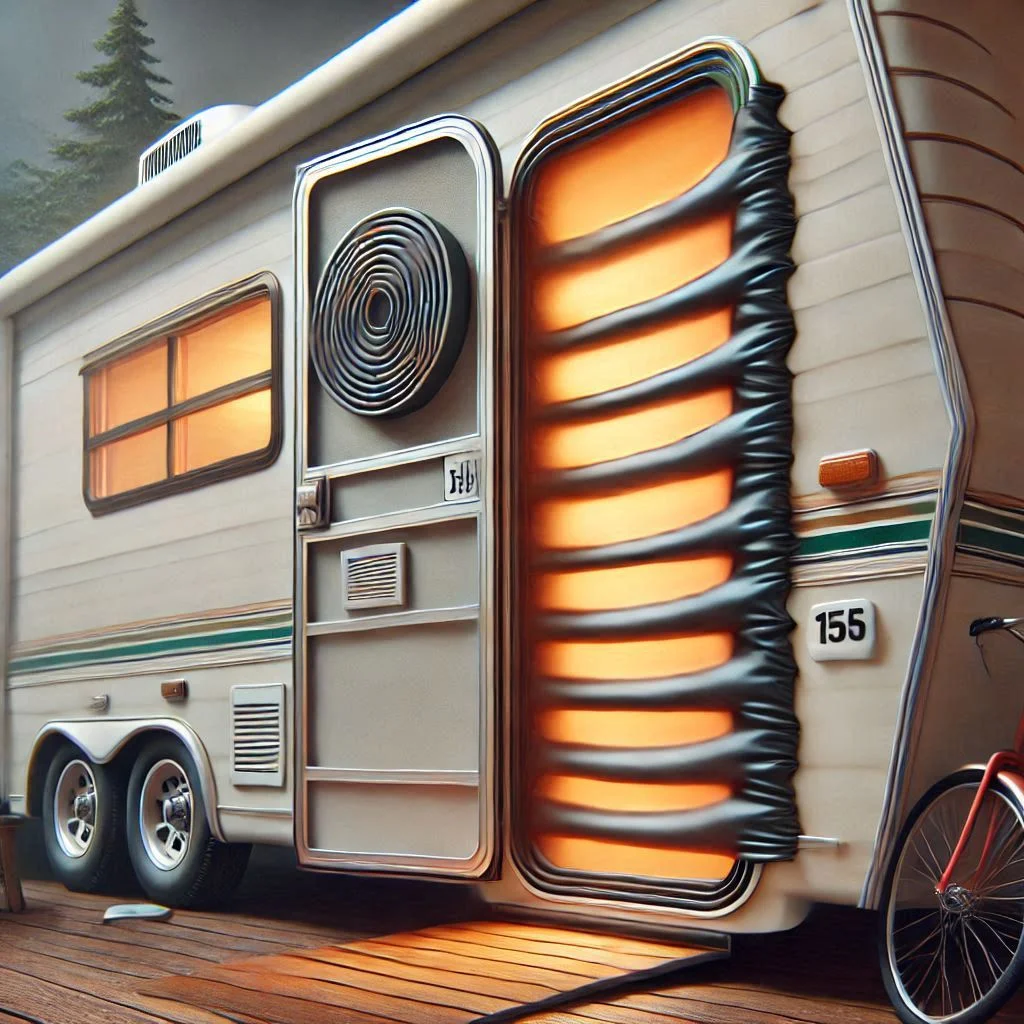
FAQ: How Can I Make My RV Air Conditioner Colder?
Q1: What Are Some Quick Fixes to Cool My RV Faster?
When you’re in a hurry to cool down your RV, the following quick fixes can help make the interior cooler faster:
- Park in the Shade: Always try to park your RV under trees, awnings, or other structures that provide shade. This will prevent direct sunlight from heating up the RV’s exterior, giving your AC a better chance to cool the interior.
- Use Portable Fans: Portable fans help circulate the cool air from your AC more effectively, distributing it evenly throughout the RV. They work by enhancing air movement and preventing stagnant hot air from building up.
- Keep Windows Covered: Closing your windows early in the morning (before the sun heats them up) and using reflective window covers will trap cooler air inside and block out external heat, improving your RV’s overall cooling efficiency.
By applying these quick fixes, you can significantly reduce the time it takes for your RV to cool down and improve your overall comfort.
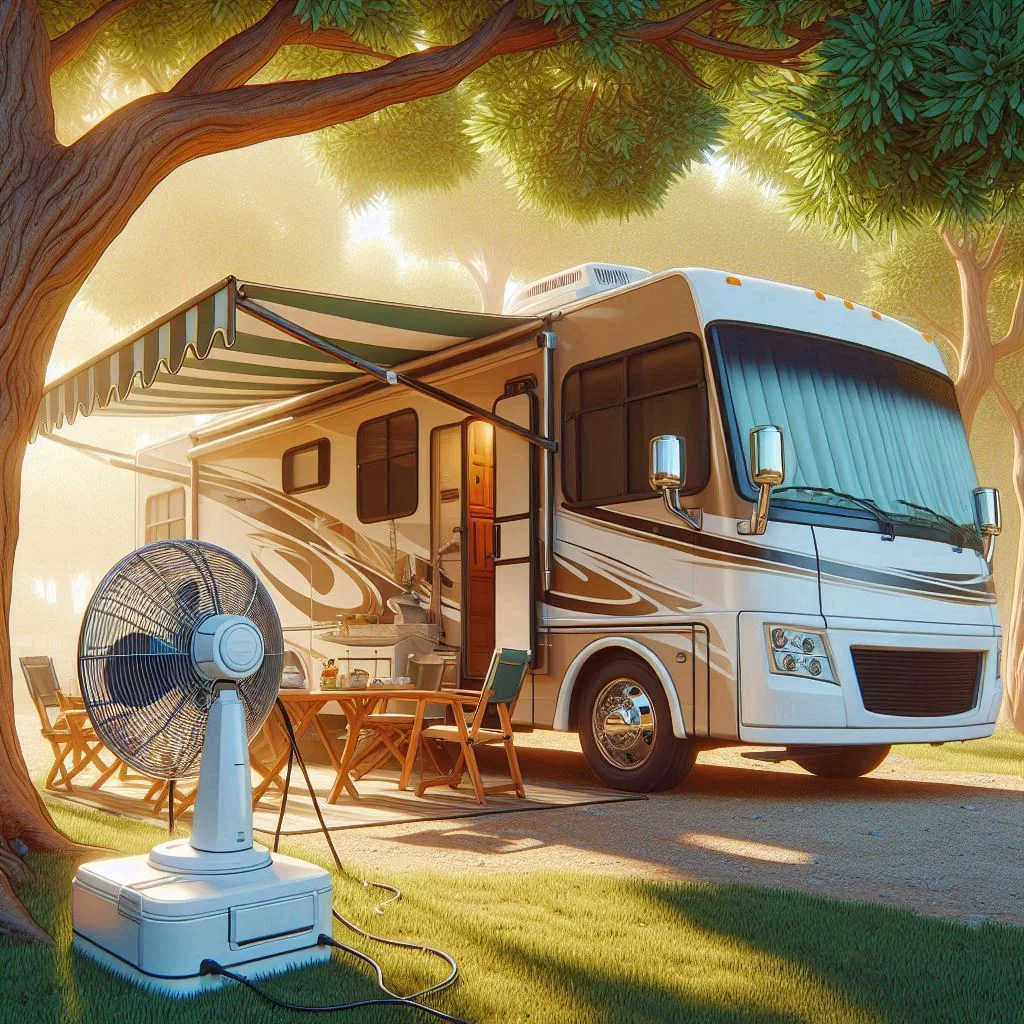
Q2: Does Using Reflective Insulation Really Help in Cooling?
Yes, reflective insulation can significantly improve your RV’s cooling performance by blocking out heat and preventing it from entering the RV. This type of insulation works by reflecting infrared radiation, which is a major source of heat buildup.
- Why It Works: Reflective materials (such as foil-backed insulation) are designed to reflect heat, especially in the form of sunlight, keeping your RV cooler during hot days.
- Where to Apply It: You can install reflective insulation on your RV’s walls, windows, and doors. Special reflective window covers can be placed over your RV’s windows, while reflective foil can be installed inside the walls to improve insulation.
Incorporating reflective insulation into your RV can reduce the need for excessive air conditioning usage and improve cooling efficiency by creating a barrier that prevents outside heat from penetrating.
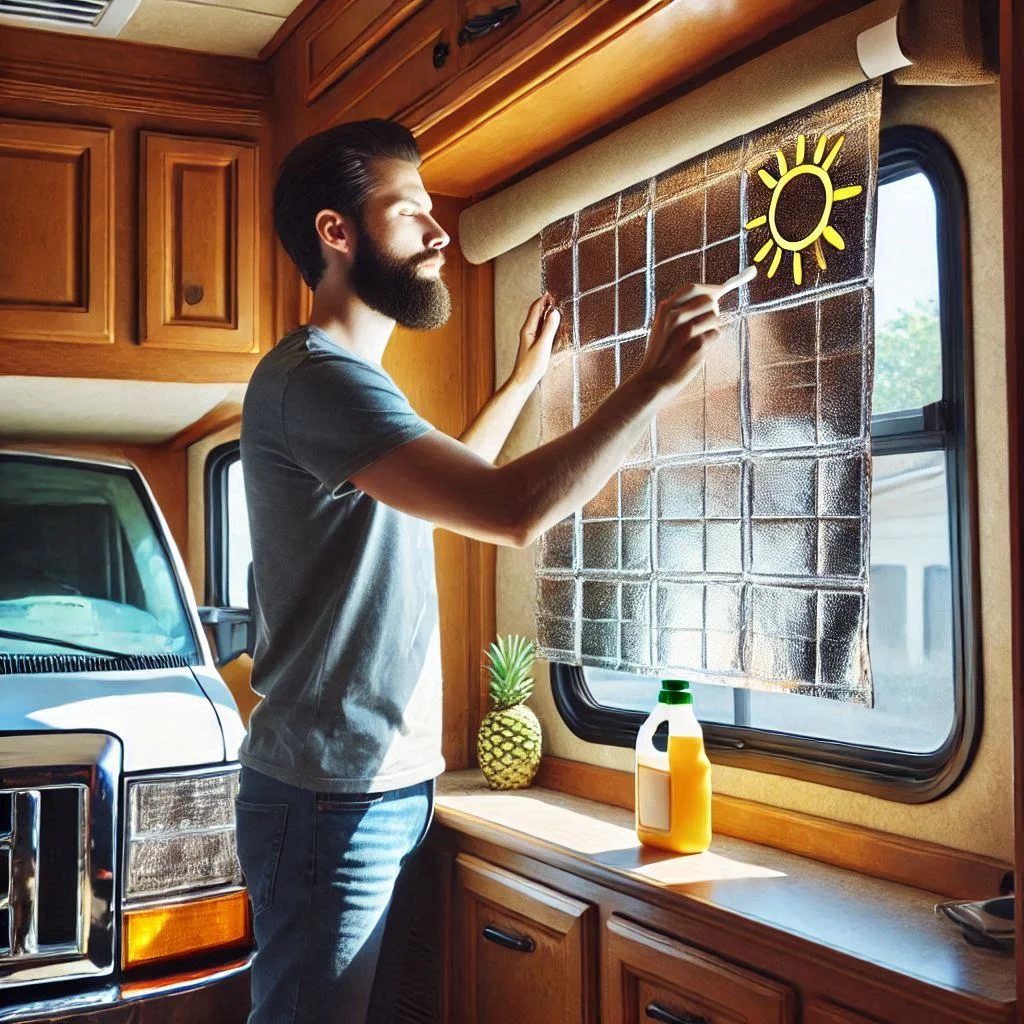
Q3: How Often Should I Clean My RV’s AC Unit for Optimal Performance?
For optimal cooling performance, it’s essential to clean your RV’s air conditioner regularly. Over time, dirt, dust, and debris can build up inside the AC unit, reducing airflow and making the unit work harder to cool the space. Regular cleaning helps maintain efficiency, ensuring your AC cools the RV faster and uses less energy.
- Recommended Cleaning Frequency: Clean the AC unit at least once every 1-2 months during the cooling season. If you’re in a dusty or humid environment, you may need to clean it more often.
- Steps for Cleaning:
- Turn off the AC and unplug it from the power source.
- Use a vacuum or soft brush to remove dust from the vents and filters.
- Clean the coils and evaporator using a coil cleaner.
- Replace or clean the air filters to ensure optimal airflow.
- Check for any obstructions in the ducts.
By regularly cleaning your AC unit, you’ll improve its efficiency and longevity, keeping your RV cooler for longer periods.
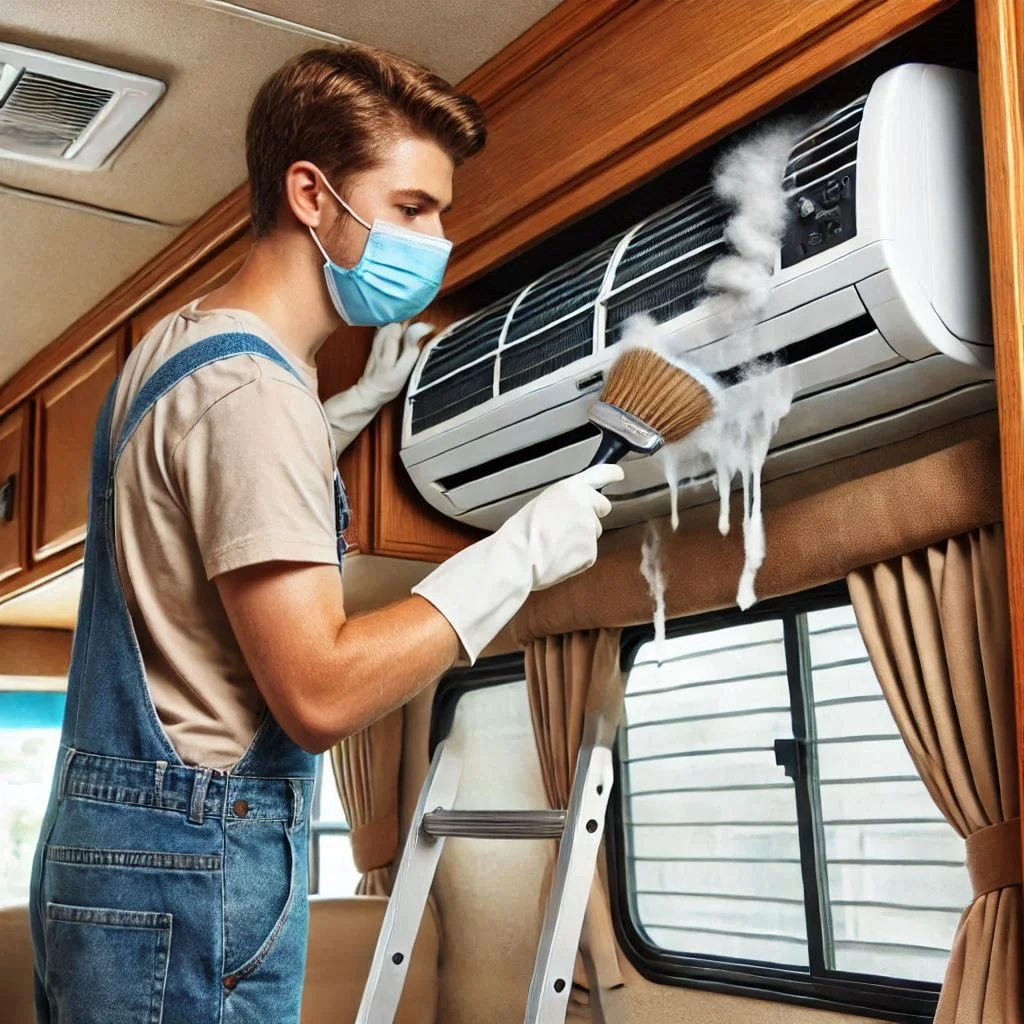
Q4: Will a Portable Fan Make a Noticeable Difference in Cooling?
Yes, using a portable fan in your RV can make a noticeable difference in cooling by enhancing the circulation of cool air throughout the space. While an AC unit lowers the temperature of the air, a fan helps to distribute that cool air more evenly, preventing hot spots and improving airflow.
- How Fans Help: A portable fan doesn’t directly cool the air but moves it around, which helps the air conditioning system distribute the cool air more effectively throughout the RV. It also assists in pushing out hot air from the RV when combined with vent openings.
- Ideal Fan Placement: Place the fan near the AC vent to help circulate cool air throughout the RV, or position it near windows to help expel hot air.
Portable fans are a cost-effective way to enhance your RV’s cooling system without consuming much energy. By keeping the air moving, the fans support your air conditioning and provide a more comfortable environment.
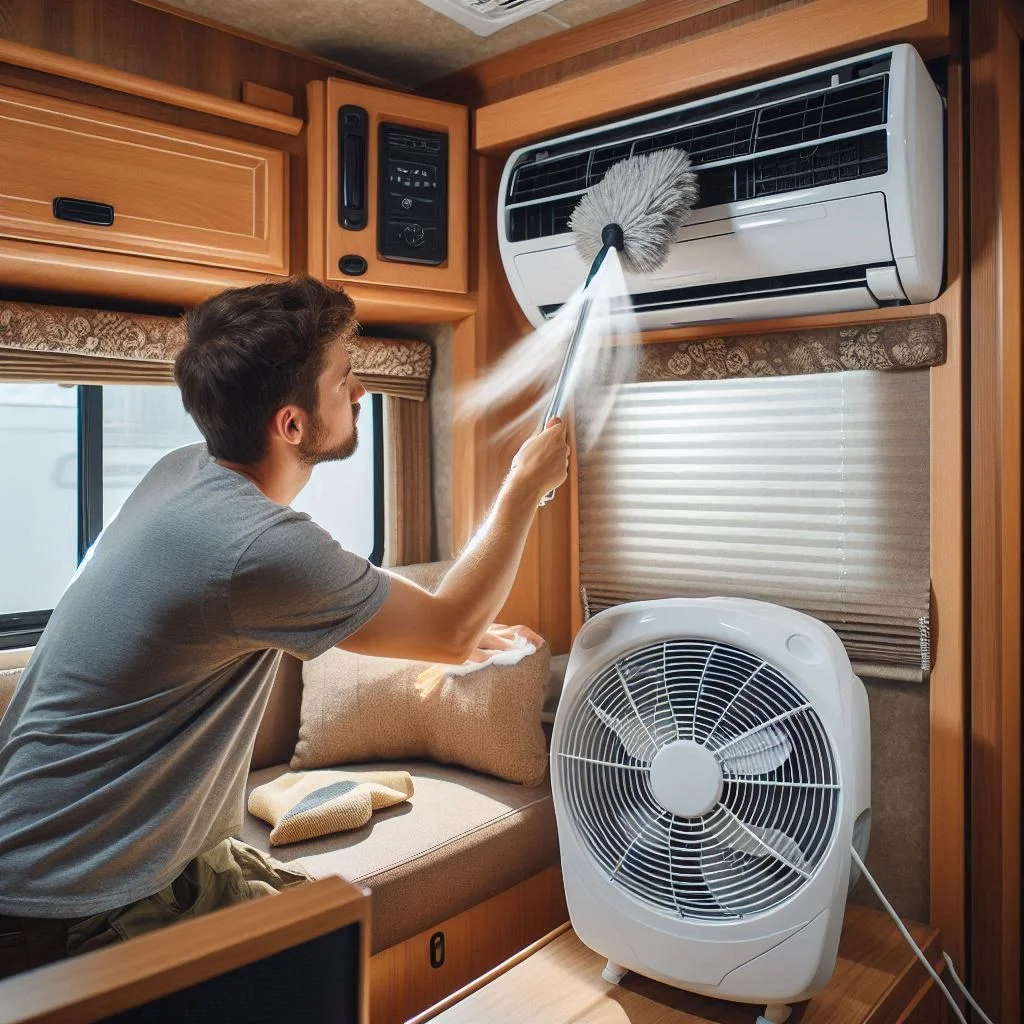
Conclusion
In conclusion, keeping your RV air conditioner cooler and more efficient doesn’t have to be a complex task. By implementing simple yet effective strategies like parking in the shade, using reflective insulation, maintaining your AC unit, and enhancing airflow with portable fans, you can significantly improve your RV’s cooling performance. Regular maintenance and thoughtful cooling practices not only create a more comfortable environment but also help save energy and reduce the wear on your AC system. With these tips and tricks, you’ll enjoy a cooler, more comfortable ride throughout your travels, even during the hottest summer days. Remember, a little effort can go a long way in making your RV a cool, relaxing oasis no matter where you are.

